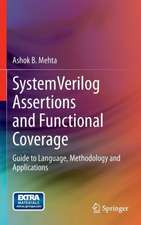Design of Low-Voltage Low-Power CMOS Delta-Sigma A/D Converters: The Springer International Series in Engineering and Computer Science, cartea 493
Autor Vincenzo Peluso, Michiel Steyaert, Willy M.C. Sansenen Limba Engleză Hardback – 28 feb 1999
A method of implementing the classic single loop and cascaded Delta-Sigma modulator topologies with half delay integrators is presented. Those topologies are studied in order to find the parameters that maximise the performance in terms of peak SNR. Based on a linear model, the performance degradations of higher order single loop and cascaded modulators, compared to a hypothetical ideal modulator, are quantified.
An overview of low voltage Switched Capacitor design techniques, such as the use of voltage multipliers, low VtMOST devices and the Switched Opamp Technique, is given. An in-depth discussion of the present status of the Switched Opamp Technique covers the single-ended Original Switched Opamp Technique, the Modified Switched Opamp Technique, which allows lower supply voltage operation, and differential implementation including common mode control techniques.
The restrictions imposed on the analog circuits by low supply voltage operation are investigated. Several low voltage circuit building blocks, some of which are new, are discussed. A new low voltage class AB OTA, especially suited for differential Switched Opamp applications, together with a common mode feedback amplifier and a comparator are presented and analyzed.
As part of a systematic top-down design approach, the non-ideal charge transfer of the Switched Opamp integrator cell is modeled, based upon several models of the main opamp non-ideal characteristics. Behavioral simulations carried out with these models yield the required opamp specifications that ensure that the intended performance is met in an implementation.
A power consumption analysis is performed. The influence of all design parameters, especially the low power supply voltage, is highlighted. Design guidelines towards low power operation are distilled.
Two implementations are presented together with measurement results. The first one is a single-ended implementation of a Delta-Sigma ADC operating with 1.5V supply voltage and consuming 100 &mgr;W for a 74 dB dynamic range in a 3.4 kHz bandwidth. The second implementation is differential and operates with 900 mV. It achieves 77 dB dynamic range in 16 kHz bandwidth and consumes 40 &mgr;W.
Design of Low-Voltage Low-Power CMOS Delta-Sigma A/D Converters is essential reading for analog design engineers and researchers.
| Toate formatele și edițiile | Preț | Express |
|---|---|---|
| Paperback (1) | 939.62 lei 6-8 săpt. | |
| Springer Us – 8 dec 2010 | 939.62 lei 6-8 săpt. | |
| Hardback (1) | 945.62 lei 6-8 săpt. | |
| Springer Us – 28 feb 1999 | 945.62 lei 6-8 săpt. |
Din seria The Springer International Series in Engineering and Computer Science
- 24%
 Preț: 1041.98 lei
Preț: 1041.98 lei - 20%
 Preț: 643.50 lei
Preț: 643.50 lei - 18%
 Preț: 1225.62 lei
Preț: 1225.62 lei - 18%
 Preț: 965.02 lei
Preț: 965.02 lei - 20%
 Preț: 646.12 lei
Preț: 646.12 lei - 18%
 Preț: 948.79 lei
Preț: 948.79 lei - 20%
 Preț: 646.62 lei
Preț: 646.62 lei - 15%
 Preț: 637.46 lei
Preț: 637.46 lei - 20%
 Preț: 643.83 lei
Preț: 643.83 lei - 18%
 Preț: 949.23 lei
Preț: 949.23 lei - 20%
 Preț: 644.48 lei
Preț: 644.48 lei - 20%
 Preț: 994.92 lei
Preț: 994.92 lei - 20%
 Preț: 645.97 lei
Preț: 645.97 lei - 18%
 Preț: 946.87 lei
Preț: 946.87 lei - 20%
 Preț: 995.57 lei
Preț: 995.57 lei - 18%
 Preț: 956.99 lei
Preț: 956.99 lei - 20%
 Preț: 644.98 lei
Preț: 644.98 lei - 15%
 Preț: 649.54 lei
Preț: 649.54 lei - 18%
 Preț: 950.21 lei
Preț: 950.21 lei - 18%
 Preț: 1221.38 lei
Preț: 1221.38 lei - 18%
 Preț: 957.62 lei
Preț: 957.62 lei - 15%
 Preț: 643.99 lei
Preț: 643.99 lei - 18%
 Preț: 948.47 lei
Preț: 948.47 lei - 18%
 Preț: 947.35 lei
Preț: 947.35 lei - 20%
 Preț: 1284.65 lei
Preț: 1284.65 lei - 20%
 Preț: 1628.31 lei
Preț: 1628.31 lei - 20%
 Preț: 1285.78 lei
Preț: 1285.78 lei
Preț: 945.62 lei
Preț vechi: 1153.19 lei
-18% Nou
Puncte Express: 1418
Preț estimativ în valută:
180.97€ • 188.23$ • 149.40£
180.97€ • 188.23$ • 149.40£
Carte tipărită la comandă
Livrare economică 14-28 aprilie
Preluare comenzi: 021 569.72.76
Specificații
ISBN-13: 9780792384175
ISBN-10: 0792384172
Pagini: 174
Ilustrații: XI, 174 p.
Dimensiuni: 155 x 235 x 13 mm
Greutate: 0.45 kg
Ediția:1999
Editura: Springer Us
Colecția Springer
Seria The Springer International Series in Engineering and Computer Science
Locul publicării:New York, NY, United States
ISBN-10: 0792384172
Pagini: 174
Ilustrații: XI, 174 p.
Dimensiuni: 155 x 235 x 13 mm
Greutate: 0.45 kg
Ediția:1999
Editura: Springer Us
Colecția Springer
Seria The Springer International Series in Engineering and Computer Science
Locul publicării:New York, NY, United States
Public țintă
ResearchCuprins
1. Introduction.- 2. ?? Modulator Topologies.- 3. The Switched Opamp Technique.- 4. Low Voltage Circuit Design.- 5. Design and Power Considerations.- 6. Implementations.- 7. Final Discussion.- Appendices.- A— Calculations for Chapter 3.- A.1 Efficiency Calculation of the Dickson Multiplier.- A.4 Calculation of the Modified Switched Opamp Integrator Transfer Function.- B— Calculations for Chapter 4.- B.1 Noise Analysis of Low Voltage Current Mirror.- B.2 Noise Analysis of New Input Stage.- B.3 Derivation of Trifferential Stage Branch Currents.- C— Settling Analysis.- C.1 Pole-Zero Pair with Frequency Lower than Gain-Bandwidth.- C.2 Pole-Zero Pair with Frequency higher than Gain-Bandwidth.- C.3 Pole-Zero Doublet at frequency higher than Gain-Bandwidth.- C.4 Two Complex Poles and a Zero.- C.5 General Conclusions.- References.

























